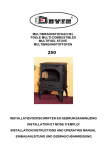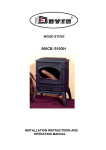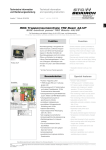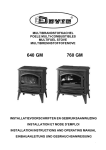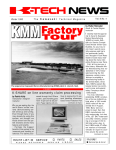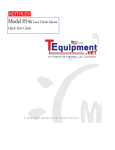Download Dovre Dovre Fireplace 2020 Technical data
Transcript
FIREPLACE 2020/2220/2520/2210/2510/2200/2500 INSTALLATION INSTRUCTIONS AND OPERATING MANUAL 2020/2220/2520/2210/2510/2200/2500 1 03.27883.100 Table of contents page Foreword 1. Introduction .......................................................................................................................3 2. Safety ...............................................................................................................................3 3. Principle............................................................................................................................4 4. Installation guideline ............................................................................................................5 4.1. Preparatory measures .....................................................................................................5 4.1.1. The chimney ........................................................................................................5 4.1.2. Ventilation ..........................................................................................................6 4.1.3. Floor, walls..........................................................................................................7 4.1.4. Combustible material round the fireplace ...................................................................8 4.2. Preparation ..................................................................................................................8 4.2.1. Changing the direction of the door-opening ................................................................8 4.2.2. Removing the clapet ..............................................................................................8 4.2.3. Fitting frame surround ...........................................................................................9 4.2.4. Assembling the “cold handle” ..................................................................................10 4.2.5. Electrical connection..............................................................................................10 4.3. Installation...................................................................................................................11 4.3.1. To be built into a new chimney ................................................................................11 4.3.2. To be built in a existing chimney ..............................................................................11 4.4. Finishing .....................................................................................................................12 4.5. Packaging materials .......................................................................................................12 5. Instructions for use ..............................................................................................................15 5.1. Fuel............................................................................................................................15 5.2. Lighting a fire ...............................................................................................................15 5.3. Burning wood ...............................................................................................................16 5.4. Burning coal .................................................................................................................16 5.5. Ash removal .................................................................................................................17 5.6. Extinguishing the fire .....................................................................................................17 5.7. Weather conditions ........................................................................................................17 6. Maintenance .......................................................................................................................18 Annex 1 : Technical data sheet ....................................................................................................19 Annex 2 : Dimensions .................................................................................................................20 2020/2220/2520/2210/2510/2200/2500 3 03.27883.100 Foreword The Installation Manual and Operators Instructions must accompany this appliance. As well as instructions for installation and information about use, you will also find advice concerning safety and maintenance. Please read this booklet carefully before installation and before firing the unit. Save this booklet and pass to any subsequent user who can also profit by it. 1. Introduction Your DOVRE purchase has made you the owner of a high quality product that sy mbolizes a new generation of energy -saving and ecologically safe heaters, producing convection heat as well as radiant heat with optimum efficiency. Through the application of a revolutionary combustion concept DOVRE heaters achieve astonishing results in full compliance with strict environmental and safety norms. Also, you will be enjoying the lovely sight of the fire blazing in the stove. Our heaters are produced in accordance with ISO 9002, using state -of-the -art produc tion means. In the unlikely event of a malfunction, you can always rely on DOVRE’s after-sales service. Any unauthorised modific ation of the appliance is forbidden and use only replacement parts recommended by the manufacturerr. This heater is designed to be installed in a living room and to be hermetically connected to a flue (chimney). If the stove is professionally installed, connected to a well-functioning chimney and sufficiently ventilated, you can take the long-term and trouble -free functioning of your heater for granted. Please consult an expert when installing and connecting the heater. The manufacturer cannot be held liable for problems caused by faulty installation. 2. Safety The heating unit is best installed, commissioned, and checked by a competent installer who is aware of national and local legislation. The heater is designed to heat a room, which means that all surfaces, including the front glass, can get very hot (> 100 °C). Please do not place any curtains, clothes, laundry, furniture or other combustible materials on or near the heater. It is advised to make a fire in the stove with the highest possible intensity right after it is installed, so as to cure the heat-resistant paint finish. This may involve some odour production, which will however disappear after a while. It is necessary to maintain and regularly clean the stove and the chimney for the stove to function safely and for a long period of time. Please follow the cleaning instructions in the chapter concerned. In case of a chimney fire, immediately close all air intake vents of the appliance and alert the fireman. Broken glass should be replaced before using the heater again. The stove is specifically designed for burning certain kinds of fuels. In the technical specifications under cover you can find detailed information concerning this topic. It is absolutely prohibited to burn fuels other than these, as this may damage your heater. Moreover, it is ecologically harmful. 2020/2220/2520/2210/2510/2200/2500 3 03.27883.100 3. Principle The Dovre model is designed to provide a fireplace convection system without the need to construct a masonry convection chamber. The principle of operation is that the cooler air from the lower part of the room is drawn under the base of the inner cast iron unit. Warm air is produced from the inner cast iron surfaces of the appliance and this warm air develops between the surfaces of the steel convection case and the outer surfaces of the cast iron combustion chamber. Flexible piping may be used to carry the warm air from the appliance to outlet grills to be located where heat is required. This can be either in the same room as the appliance or in other rooms even at first floor level. It is essential to ensure that the warm air flexible pipes are allowed to rise from the appliance. The cooler room air entering the lower level moves the warm air by convection, and fan assistance whilst the fans are operating, to be discharged into the room through the space at the top of the appliance or via flexible pipework. 1. Primary combustion air 2. Secondary combustion air 3. Cool air for convection 4. Convected warm air 5. Twin power fans for boosting convection 6. Passage of combustion air 7. Removable ashpan 8. Rear protection plate 9. Passage of flue gases 10. Outer convectioncasing 11. Clapet 2020/2220/2520/2210/2510/2200/2500 4 03.27883.100 4. Installation guideline 4.1. Preparatory measures The fireplace should be hermetically connected to a well-functioning chimney, sufficiently enclosed to keep combustible materials (floor and walls) at a distance, and should be installed in a room with sufficient ventilation. Please inform about national or local norms and regulations concerning this subject. Your distributor will give y ou the necessary advice. You can also consult the fire department and/or an insurance company about specific demands or regulations. Please read the technical specifications under cover in this manual before installing the appliance. 4.1.1. The chimney The chimney (the flue) has a double function: • • It draws air, that is necessary for good combustion, into the stove. It functions as an exhaust pipe for combustion gases via thermal or natural draught. Thermal draught is caused by the difference in heat between the air inand outside the flue. The heated air in the flue is lighter than the colder air outside the flue and consequently rises up, along with the combustion gases. Natural draught is caused by environmental phenomena, such as wind. It is prohibited to connect several heaters to one chimney (for instance the central heating boiler), unless local or national regulations allow this. Please check which chimney is to be used for the stove you purchased and whether your chimney is appropriate for this specific usage. You should consider an expert's opinion on this matter. The chimney should meet the following conditions: • The flue should be made of fireproof material. Ceramic or stainless steel is recommended. • The chimney should be airtight and thoroughly cleaned and should guarantee a sufficient draught (a draught or negative pressure of 15 to 20 Pa is ideal under normal circumstances). • It should run as vertically as possible. Changes in direction or horizontal segments will disrupt the smoke flow and may cause soot to cumulate inside the flue (and clog the flue!). • The chimney's inside dime nsions must not be too large in order to prevent the smoke from cooling off too much. For recommended chimney dimensions, see the technical specification under cover. Larger dimensions can be used if the flue is well insulated. • The flue's diameter should be the same throughout its whole length. Wider, or especially narrower segments will disrupt the smoke flow and are best avoided. 2020/2220/2520/2210/2510/2200/2500 5 03.27883.100 The same is true for a cover plate or exhaust hood on top of the chimney. The exhaust hood must not narrow the chimney's outlet and should be designed in a way that wind will not hinder, but promote the smoke flow. • Especially if the flue runs through unhe ated rooms or outside the house, further insulation is necessary. Metal chimneys, or parts of the chimney outside heated rooms should always have double -walled, insulated flues. The part of the chimney outside the roof should always be insulated. • The chimney should be high enough (at least four metres) and should end in a zone that is clear of nearby buildings, trees or other obstacles. The rule of thumb here is: 60 cm above the ridge of the roof. If the distance between the ridge and the chimney measures more than three metres, see the dimensions stipulated in the illustration below. Depending on the presence of nearby buildings or trees, the chimney should be higher. 33mm min 0.5mm min 0.5 min 1 m highest point of the roof within a distance of 3 m. 4.1.2. Ventilation The burning of wood, charcoal or gas involves oxygen consumption. It is of the utmost importance that the room in which the stove is installed should be sufficiently ventilated. Insufficient ventilation may disrupt the combustion process and cause the smoke flow through the chimney to be interrupted, which may lead to smoke emissions into the room. Mainly in case of a fireplace, together with the combustion gases, lots of room air will be extracted through the chimney; that makes supply of sufficient fresh air and ventilation extremely important. If necessary, you can install a ventilation grille to provide a constant flow of fresh air in the room. This precaution is particularly necessary in well-insulated rooms with mechanical ventilation. The DOVRE fireplace has been designed to produce most heat by means of convection. Heat is mainly transmitted through the back panel, the lateral panels, and the smoke dome. Both the material (cast iron) and shape (increased heating surface by means of corrugation) improve heat transmission to the surrounding air. As this air is heated, it will rise and a natural hot air flow, i.e. convection, will develop. Up to your choice, that hot air may be led to the same room or to another room. For optimal heating and leading the convection air, the airflow must not encounter any obstacles. Hence, it is important that there is enough space between the fireplace and the surrounding material, and that the inlet and outlet area of convection air are sufficiently large. 2020/2220/2520/2210/2510/2200/2500 6 03.27883.100 Convection air may be led to arrive from both the room and outside (other room, cellar, exterior) to the bottom side of the fireplace. In case convection air is supplied (directly or indirectly) from outside, it may also be useful as a supply of fresh air for combustion. At any rate, assure proper home air management and sufficient air supply into the room. Ensure not to use other air-consuming appliances, such as heaters, cooking hoods, bathroom ventilators, in the same room or in the house while the stove is burning; or make sure to have an extra ventilation grille installed for these appliances. 4.1.3. Floor, walls The appliance shall be installed on floors with an adequate load-bearing capacity. Combustible material must be sufficiently protected. The floor under the fireplace and the walls around it must not contain electric wires. Under the appliance Under the appliance, any combustible material must be removed or specially shielded by means of a 6 cm concrete slab and 10 cm insulation. The legs of the appliance may rest directly on the concrete slab and insulation must be applied inbetween the legs. Floor round the appliance A floor made of combustible material must be properly shielded in the following areas: Front: height of the lower part of the fire chamber + 30 cm, but 60 cm at least. Sides: height of the lower part of the fire chamber + 20 cm, but 40 cm at least. VV >> HH +30 + 30 > 60 > S60 > H + 20 > 40 Maten in cm H V S Walls, ceiling Combustible walls behind, next to, or above the fireplace must be shielded with at least a 10 cm stone or brick wall and 10 cm insulation. Fireproof materials should be covered with at least 6 cm insulation. 2020/2220/2520/2210/2510/2200/2500 7 03.27883.100 4.1.4. Combustible material round the fireplace Within the radiation area of the fireplace Assure a distance of at least 80 cm between the opening of the fireplace and combustible material. That distance may be reduced to 40 cm if the combustible material is sufficiently shielded and well ventilated. Outside the radiation area of the fireplace Assure a distance of at least 5 cm between the mantle built around the fireplace and combustible material. A small surface contact between combustible material and the mantle (e.g. wall cladding) is allowed if the mantle of the fireplace is sufficiently insulated. A wooden ornamental rafter must not be installed within the radiation area of the fire. Outside the radiation area, there must always be a ventilation gap of 1 cm all around to prevent heat from building up (see picture). min 1 cm min 1 cm No combustible material must be present within 50 cm from the convection outlet areas. 4.2. Preparation Please inspect the fireplace for damage caused during transport immediately after delivery and notify your distributor in case there are any defects. Do not put the appliance into operation in the meantime. In order to avoid damaging the fireplace during installation and to make its handling easier, it is recommended to remove previously all loose parts (fire-resistant bricks, grille, ashtray, ...) from the stove. Note the location of those parts while removing them, so that you have no difficulties in re-assembling the parts later on. 4.2.1. Changing the direction of the door-opening It is possible to change the direction of the door ope ning. On each side you have already the system. 4.2.2. Removing the clapet You can remove the clapet and the tige by holding it upward and moving it a little over the baffle -plate. When you loose the bolt in the topplate you can remove the baffle plate. 2020/2220/2520/2210/2510/2200/2500 8 03.27883.100 4.2.3. Fitting frame surround The decorative frames, 3 and 4 sides versions are fitted to the applaice after installation. Ensure that sufficient space is allowed to both sides of the recess. 2020/2220/2520/2210/2510/2200/2500 9 03.27883.100 4.2.4. Assembling the “cold handle” Assemble the different parts of the handle, I.e. a screw M8x50, a wooden handle and a nut, as indicated on the sketch. 4.2.5. Electrical connection For protection, the unit must always be connected to power. The appliance is supplied with a speed control to vary the running speed of the fans. This can be left trailing or fitted o the wall mounting supplied. 2020/2220/2520/2210/2510/2200/2500 10 03.27883.100 4.3. Installation The appliance is designed to be built into a new or existing chimney breast installation to provide space heating by radiant an convected heat. 4.3.1. To be built into a new chimney Build the new fire place around the appliance ensuring that no materials are built onto the appliance. Before constructing the fireplace facing wall (section between top of appliance and underside of raft lintel, fit a support lintel supported by the side walls and build the face wall using lightweight insulated building blocks backed with insulated panels. Never build directly onto the appliance. If flexible warm air ducts are to be used, install air grills at the outlet locations to allow passage of warm air to the specific area. Where the fireplace backs onto another room or is in the corner of a room, backing onto two rooms, grills van be fitted in the adjoining room or rooms. Never use grills made from plastic or other combustible materials. Ensure that the weight of the main chimney or chimney flue liners is not directly supported by the appliance. Flue liners must be supported independently of the appliance. 4.3.2. To be built in a existing chimney The recess should be formed using an appropriately designed raft lintel to support the existing brickwork structure and chimney. The minimum clearance between the back of the appliance and the rear should be 1,5 cm. It is recommended to fix insulating panels to the sides, back and top of the appliance. Never allow marble, granite or masonry to be in direct contact with the metal outer box of the appliance. Always use insulation. Prepare the opening ensuring that adequate support is provided for the chimney and existing brickwork structure. Ensure that enough height is allowed to adequately connect the appliance to the main chimney. If necessary, construct a raft lintel to form the top of the recess to support the chimney and surrounding masonry. This could be pre -formed with a minimum diameter 150 mm clearance hole incorporated for the connecting minimum diameter 150 mm flue pipe. If the recess is too wide, use insulated building blocks to reduce the width. Clean thouroughly the floor, wall and top of the recess. Stand the appliance in the recess and use a spirit level to ensure the unit is level and plumb. If an exiting masonry is installed, the appliance should be connected to the chimney using minimum diameter 150 mm, stainless steel pipe. It is important to ensure that the connection to the chimney is carried out in such a way that any soot particles are allowed to fall un-hindered back into the appliance. Ensure that the weight of the main chimney or chimney flue liners is not directly supported by the appliance. Flue liners must be supported independently of the appliance. 2020/2220/2520/2210/2510/2200/2500 11 03.27883.100 4.4. Finishing When the appliance is installed in the right place, its connection with the chimney made airtight, and the masonry mantle completely mounted, all loose parts are installed in the appliance. Your fireplace is now ready to be used. Depending on the materials used for mounting, it is recommended to wait for some time until all masonry is dry before lighting a fire. Attention: never light a fire with the inner plates or refractory stones removed. 4.5. Packaging materials Packaging materials should be disposed of in a responsible way and in accordance with governmental regulations. 2020/2220/2520/2210/2510/2200/2500 12 03.27883.100 Chimney Combustible ceiling Refractory cement or special connector Opening against eventual pressure buildup Isolation (min 5 cm) Extra opening for ventilation fireplace Fireproff wall min 10 cm Stainless steel pipe Insulation (if necessary) Combustible wall Canvection air outlet Convection air (min 15 mm) Convection air inlet Fireproof floor Combustible floor Example of fireplace installation within combustible material 2020/2220/2520/2210/2510/2200/2500 13 03.27883.100 Existant chimney Extra opening for ventilation firepalce Refractory cement or special connector Existant fireplace Opening against eventual pressure builup Convection air outlet Ventilation: min 15 mm) Convection air inlet Example of installation in an existante fireplace 2020/2220/2520/2210/2510/2200/2500 14 03.27883.100 5. Instructions for use 5.1. Fuel The only suitable fuels for this stove are wood, brown coal briquettes and charcoal (when you use a coal-basket). No other fuels are allowed to be burnt, as they can inflict serious damage to your stove. Do not burn any tre ated wood either, such as scrap wood, dyed wood, impregnated or preserved wood, plywood or chipboard. The fumes of these, as of synthetic materials, old papers and household waste, are highly polluting for both your stove and your chimney, and for the environment. Theyalso could cause chimney fires. Wood Hard woods, such as oak, birch- and fruit-trees, are the ideal fuels for your stove. The wood must have dried for at least two years in a covered and well-ventilated place. Split logs will dry faster. Dry wood should contain no more than twenty pe rcent moisture. Wet logs are unsuitable for burning, as they do not produce enough heat and all of the energy is lost in the process of evaporation. Moreover, the burning of wet wood causes badly smelling gases to be released and a thick layer of tar will deposit on the stove panels and in the chimney. Brown coal briquettes Brown coal briquettes burn in more or less the same way as wood does. You should only burn briquettes on a bed of charcoal in your stove. Charcoal There are several categories of anthracite coal. Some characteristics may be legally determined. For instance anthracite “A” has to contain less than 10% of volatile substances, anthracite “B” less than 12%. The ash content may range from 3 to 13%. For a good operation of your appliance, the use of anthracite “A” with a low ash content is recommended. A combustible with a high ash content has a lower net heating value. Moreover, the ashes have to be removed more frequently and the fire will go out faster. The recommended calibre is 12/22 or 20/30. 5.2. Lighting a fire In order to c reate sufficient draught and to prevent smoke from being emitted into the room, the chimney should be warm enough before lighting a fire. A cold chimney can be heated up by lighting a ball of paper above the fire plate. To kindle the fire in the stove you can use paper and/or firelighters and small pieces of wood. Slightly open the door. It is important that the kindled fire should burn intensely. You can then throw larger pieces of wood onto the fire, and close the doors. When the fire has stabilized and is 2020/2220/2520/2210/2510/2200/2500 15 03.27883.100 glowing enough, you can put the logs, the charcoal or the brown coal briquettes on the fire. 5.3. Burning wood Always keep the stove doors tightly closed. Never let the doors open when the fire is burning. Add extra fuel when necessary. Never add too much fuel. It is best to fill the stove for one third and to top it up on a regular basis. Always open the filling door slowly and for a short space of time. Before filling up, the charcoal bed should be carefully spread open. Check whether the coals are glowing enough just behind the log retainer, so that the added fuel will immediately catch fire. If necessary you can open the lower air slide for a while. Open stacking will make the logs burn very intensely, as the oxygen can easily reach every part of the fire. This method of stacking is applied when burning wood for a short while. Compact stacking will make the fire burn slower, as the air can only reach the outer parts of the fire. This stacking method is best used when burning for a longer while. Low intensity fires cause tar and creosote to deposit in the chimney after a long period of time. Tar and creosote are highly comopen stacking compact stacking bustible substances. Thicker lay ers of these substances might catch fire when the temperature in the chimney increases suddenly and steeply. Therefore it is necessary for the fire to regularly burn very intensely, so that thin layers of tar and creosote immediately disappear. Low intensity fires also cause tar to deposit on the stove panes and doors. When it is not too cold outside it is better to let the stove burn intensely for just a few hours a day. 5.4. Burning coal You need a coal-basket for burning coal. WHEN BURNING CHARCOAL THE AIR SLIDE ABOVE MUST ALWAYS BE KEPT CLOSED. As soon as the fire is sufficiently stable and there is enough glow, the first shovel of coals can be put onto the fire. Complete the filling once the coals have caught fire. Make sure you do not quench the fire by 2020/2220/2520/2210/2510/2200/2500 16 03.27883.100 Before adding some extra coals, use the shaker grate or the supplied shovel, and shake till the glowing parts fall into the ash plate; then add the coals. After a few minutes, add some more coals until you can only see the glow of the previous filling. When the fire basket or the cast-iron plate fins are red-hot, you are heating too intensely. 5.5. Ash removal If your fireplace is equipped with an ashtray (optional), it must be emptied before the ashes reach the lower edge of the combustion grid. With the cold handle supplied, you can tilt the grid upwards and remove the ashtray from the device. Relatively speaking, burning wood produces little ash and it will not be necessary to remove it each time daily. Moreover, wood burns better on a bed of ash. 5.6. Extinguishing the fire Stop fuelling the fire and let it burn out. You should let the fire burn out and keep an eye on it as long as it is still glowing. 5.7. Weather conditions Attention! Mist and heavy fog will block the chimney's smoke outlet and may lead to smoke emissions into the living room. It is best not to use the fireplace under these weather conditions. 2020/2220/2520/2210/2510/2200/2500 17 03.27883.100 6. Maintenance It takes only little effort to keep your appliance in good condition. Regularly check whether the sealing cord still closes the doors tightly enough. Minor paint damage can be touched up with a can of spray paint. Your dealer can supply you with the correct spray product. During the first use after repainting your unit might give off some slight odour. However, this will disappear quickly. The glass can be cleaned with a number of glass cleaning products available on the market. Your installer can also supply you with appropriate products. However, never use abrasive or corrosive cleaning products. At the end of the heating season, seal off the chimney with a ball of paper. You can then thoroughly clean the stove on the inside. If necessary, replace the sealing ropes and use fire cement to fill up possible leaks. Remove the fireplate for better and more thorough cleaning. To remove the doors, disassemble the hinges as shown. You should have your chimney swept by an expert before the heating season begins. It is useful to check the chimney for soot during the heating season as well. Checking and maintaining the chimney is a statutory requirement. When all of the above advice is heeded, you will be able to fully e njoy your stove. 2020/2220/2520/2210/2510/2200/2500 18 03.27883.100 2020/2220/2520/2210/2510/2200/2500 19 03.27883.100 9.2 g/s 320 °C Flue gas mass flow Flue gas temperature 0.14 mbar 80 % Efficiency Minimum draught 0.10 % Hout Bois Wood Holz Kolen Charbon Coal Kohlen 0.14 mbar 360 °C 9.7 g/s 76.4 % 0.09 % 79 % 0.05 % 0.14 mbar 360 °C 9.0 g/s 78.1 % 0.10 % Hout Bois Wood Holz 0.14 mbar 360 °C 12.3 g/s 71.1 % 0.03 % Bruinkool lignite Browncoal Braunkohl 150 mm 150 mm Bruinkool lignite Browncoal Braunkohl 10 kW 2510D / 2520/2/3 10 kW 2500 / 2510 / 2520 % CO Advised combustibles Flue connection (diametre) Nominal heat output Model Annex 1: technical data sheet 0.14 mbar 340 °C 7.7 g/s 78.3 % 0.10 % Hout Bois Wood Holz 0.14 mbar 340 °C 8.9 g/s 75.4 % 0.06 % Bruinkool lignite Browncoal Braunkohl 150 mm 76.5 % 0.04 % Kolen Charbon Coal Kohlen 8 kW (2020: 7 kW) 2200 / 2210 / 2220 / 2020 Annex 2 : Dimensions 2500 2200 2020/2220/2520/2210/2510/2200/2500 20 03.27883.100 2210S 2510S 2220 2520S 2020/2220/2520/2210/2510/2200/2500 21 03.27883.100 2510D 2020S 2520S/2/3 2020/2220/2520/2210/2510/2200/2500 22 03.27883.100 CE-conformiteitsverklaring Declaration de conformité CE EC Declaration of conformity Konformitätserklärung CE Notified body: 1625 Wij, Nous, We, Wir, Dovre nv Nijverheidsstraat 18 B2381 Weelde verklaren bij deze dat de inzithaarden 2020; 2220; 2520;2210;2510; 2200; 2500 conform zijn volgens de EN 13229. déclarons que les foyers 2020; 2220; 2520;2210;2510; 2200, 2500 sont conforme au norme EN 13229. declare that the fireplaces 2020; 2220; 2520;2210;2510;2200; 2500 are in conformity with the EN 13229. Erklären daß das Produkt 2020; 2220; 2520;2210;2510; 2200; 2500 entspricht EN 13229. Weelde, 19.09.2005 In het kader van een continue productverbetering, kunnen specificaties van het geleverde toestel afwijken van de beschrijving in deze brochure, zonder voorafgaande kennisgeving. Dans le cadre d’une amélioration constante des produits, les spécifications du produit livré peuvent différer du contenu de ce document, sans avis préalable. Due to continuous product improvement, specifications of the delivered product may differ from the content of this booklet, without further notice. Im Rahmen kontinuerlicher Produktverbesserung, können Specifikationen des geliefertes Produktes von den Beschreibungen in dieser Broschure abweichen. DOVRE N.V. Tel : +32 (0) 14 65 91 91 Nijverheidsstraat 18 Fax : +32 (0) 14 65 90 09 B-2381 Weelde E-mail : [email protected] ___________________________________________________________ 03.27883.100 0608 2020/2220/2520/2210/2510/2200/2500 72 03.27883.100























